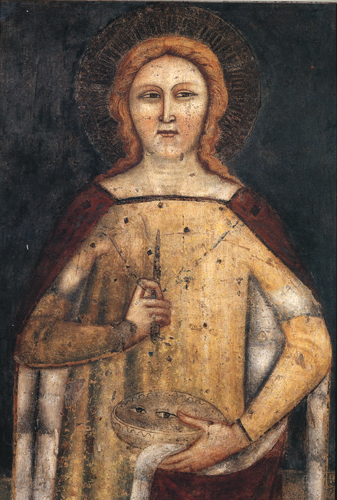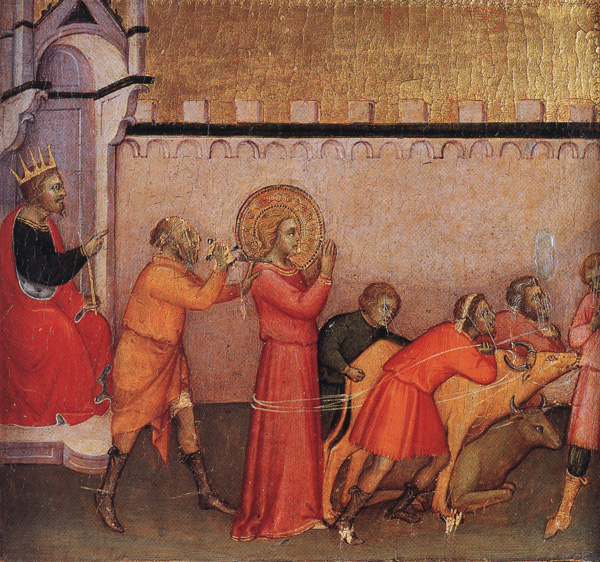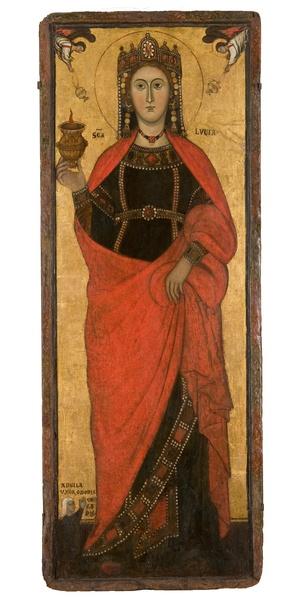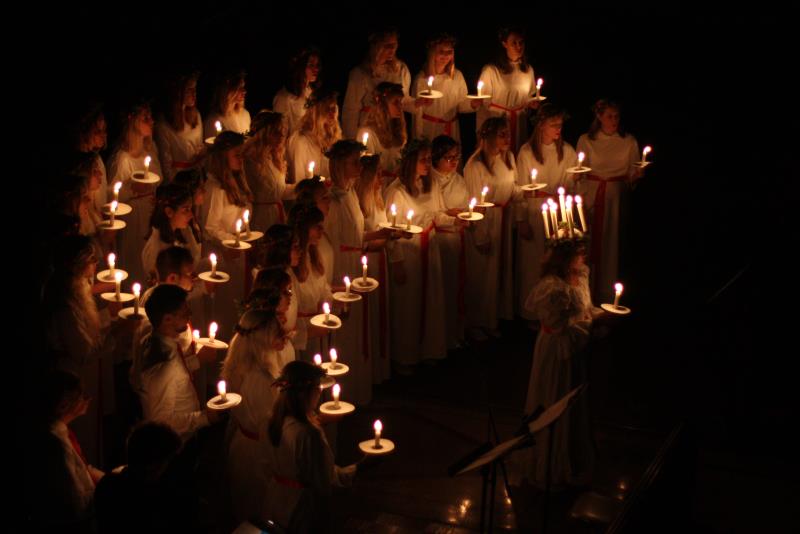


As the calendar approaches the winter solstice, our thoughts turn to Saint Lucy, whose feast day on December 13 shares many of the same themes of light and hope. A modern viewer’s first encounter with medieval images of the early Christian saint Lucy might seem somewhat gruesome. The Index holds 139 records with the subject Lucy of Syracuse, and in many, as you will notice, she is represented holding a dish or tray bearing two eyes (Fig.1). This peculiar attribute derives from her hagiography, in the course of which the saint’s eyes were gouged out.
The narratives related to this eye-gouging seem to have developed only in the later Middle Ages, and they are inconsistent: some recount that her Roman persecutors tore her eyes out as part of her martyrdom; others claim that she herself did it to present them to an unwelcome suitor who admired her beauty—take your pick!

In case you were wondering—and those of you who are acquainted with fourth-century martyrs will probably have already guessed it—in neither version of the story was eye-gouging the cause of Lucy’s death. As is almost always the case in such stories, after several other tortures, her head was cut off. This leads us to the other way Lucy is often represented, either holding a dagger or with a dagger thrust into her throat (Fig.2).

But there is much more to the Lucy story than martyrdom details. According to her vita, Lucy was an early Christian during the reign of Diocletian. She decided to devote her life to God and leave her inheritance to the poor. But without her knowing, Eutychia, her mother, had already arranged her marriage. When she called off the wedding, her suitor was indignant (no surprise there) and in revenge reported her as a Christian to the Roman authorities. Although this part of Lucy’s life is less often represented than her martyrdom, some images of this period were also produced. An example is the Index subject Lucy of Syracuse, Giving Dower to Poor. As depicted by Giovanni di Bartolommeo Cristiani (active 1367–1398), Lucy appears flanked by Eutychia (Fig.3). Her left hand reaches into a decorated purse, while with her right hand she offers a coin to a man leaning on a crutch and cane. He is followed by a veiled woman and five men, all wearing hats, one with an arm in a sling and a wooden leg, and two holding canes, one probably blind. All, presumably, will be the beneficiaries of Lucy’s generosity.

Having heard that Lucy was a Christian, Paschasius, the Governor of Syracuse, commanded that she be brought to a brothel for prostitution. But when the guards tried to seize her, her body became too heavy to be lifted. In response they decided to tie her to several oxen to drag her, but she would remain immobile. This is the episode represented by Bartolo di Fredi Montalcino in the second half of the fourteenth century (Fig.4). Paschasius, seated and crowned, is at the far left, while Lucy stands at the center of the composition, with her tormentor behind her; she is tied with ropes to three oxen and a group of men trying desperately to make her move.

Since she was unmovable, her attackers next decided to cut bundles of wood and burn her alive. Although this might have seemed a solid choice, it also failed: Lucy remained unscathed and unburned. Eventually, as represented in the illumination for her feast day in the Menologion of Basil II (976–1025), she was martyred by sword in ca.304, in Syracuse in Sicily (Fig.5).
In addition to the Index subject Lucy of Syracuse, Martyrdom, Saint Lucy can also be found tagged with subjects Martyrdom, by Beheading and Sword (Martyrdom Instrument). Yes, at the Index we like to be thorough! If you’re interested in learning more about how martyrdom was represented in the Middle Ages, you can find all martyrdom types in the Index Subject browse list, where you will find instances of martyrdom by boiling oil, disembowelment, dragging by horse, and hanging by hair, for example. If searching for the instruments, you also can go to our Subject Classification and click Religious Subjects > Christianity > Saints > Martyrdom Instruments.

But enough about martyrdom. Medieval and modern devotion to Saint Lucy is deeply tied to her name: Lucia in Latin, which shares the root luc with the Latin word for light, lux, and by extension with sight. Because of this connection, she is often shown with a torch or a burning lamp, as in this thirteenth-century panel painting, today in the Musée de Grenoble (Fig.6). Lucy appears here richly dressed as a Byzantine empress, wearing a crown with precious jewels and pendula of pearls, and holds a lighted lamp in her right hand. She is flanked by two winged angels swinging censers, emerging from above. On the foreground, to the left, the female donor, Angila Cerroni, veiled, kneels with her joined hands raised in prayer.

Just like Angila Cerroni, many other devotees found themselves invoking Lucy against blindness, eye disease, sore throat, fire, and poverty; penitent prostitutes also called on her. Perhaps because Lucy’s feast day, December 13, originally coincided with the winter solstice, marking the shortest day of the year, she is especially celebrated in the Northern Hemisphere. In Scandinavian tradition even today, the oldest daughter in the family may dress in white and wear a crown of candles on her head, bringing light, just like Lucy, in the darkness of winter.
Contributed by M. Alessia Rossi, Art History Specialist.